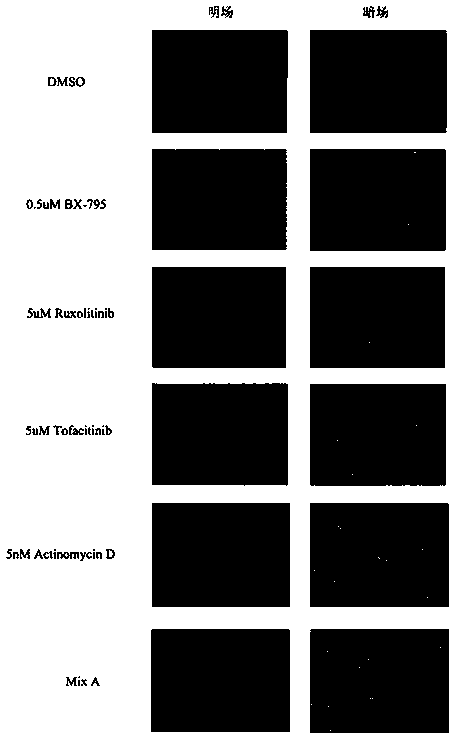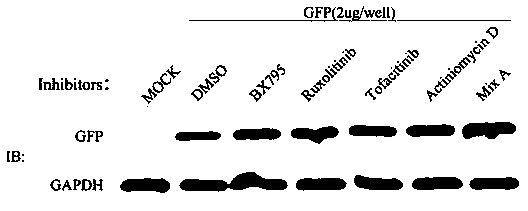Reagent composition for improving cell transfection efficiency
A technology of transfection efficiency and composition, which is applied in the direction of introducing foreign genetic material, microorganisms, and using microcapsules using vectors, can solve problems such as lack of means, achieve high transfection efficiency, simple operation, and improve transfection and expression effects. Effect
- Summary
- Abstract
- Description
- Claims
- Application Information
AI Technical Summary
Problems solved by technology
Method used
Image
Examples
Embodiment 1
[0047] Example 1 Verifying the Effect of Mixture A on Cell Transfection Efficiency in L929 Cells
[0048] The test method is as follows:
[0049] In this experiment, liposome Lipofectamine 2000 transfection method was used to transfect L929 cells. Seed L929 cells in a 6-well plate according to the appropriate concentration, in the presence of 5% CO 2 Cultivate in a 37°C incubator for 12 hours. When the cells are completely attached to the wall and grow to 60-90%, the transfection can begin; change the medium 1 hour before transfection, and use 1 ml of fresh DMEM complete medium containing 10% FBS Replace the old medium; add mixed solution A to the DMEM complete medium, the ratio of mixed solution to medium is 1:1000; the final concentration of mixed solution A in the medium is 0.25 μM BX795, 5 μM Ruxolitinib, 5 μM Tofacitinib Citrate, 5 nMactinomycin D. Prepare the transfection mixture: in a 1.5 ml round-bottomed sterile tube, mix 40 μl of Opti-MEM solution and 2 μl of Lipo...
Embodiment 2
[0051] Example 2 In L929 cells, the effect of mixing drugs in pairs on transfection efficiency was verified
[0052] The test method is as follows:
[0053] In this experiment, two mixtures of BX795 (final concentration 0.25 μM), Ruxolitinib (final concentration 5 μM), TofacitinibCitrate (final concentration 2.5 μM) and Actinomycin D (final concentration 5 nM) were prepared in proportion to 6 groups, and the control group was The solvent DMSO was added to the complete DMEM medium (1 μl DMSO / ml DMEM medium); the experimental group was L929 cells in which two mixed drugs were added to the complete DMEM medium: BX795+Ruxolitinib, BX795+Tofacitinib Citrate, BX795+Actinomycin D, Ruxolitinib+ Tofacitinib Citrate, Ruxolitinib+Actinomycin D, Tofacitinib Citrate+Actinomycin D.
[0054] In this experiment, liposome Lipofectamine 2000 transfection method was still used to transfect L929 cells. L929 cells were seeded in 6-well plates in 5% CO 2 Cultivate in a 37°C incubator for 12 hour...
Embodiment 3
[0056] Example 3 In L929 cells, verify the influence of three drug mixtures on transfection efficiency
[0057] The test method is as follows:
[0058] In this experiment, any three drug mixtures of BX795 (final concentration 0.25 μM), Ruxolitinib (final concentration 5 μM), TofacitinibCitrate (final concentration 2.5 μM), and Actinomycin D (final concentration 5 nM) were divided into 4 groups in proportion , the systems are: 1 control group, the solvent DMSO (1μl DMSO / ml DMEM) was added to the complete DMEM medium; 2-4 experimental groups were L929 cells mixed with three drugs added to the complete DMEM medium: BX795+Ruxolitinib+ Tofacitinib Citrate, BX795+Ruxolitinib+Actinomycin D, BX795+Tofacitinib Citrate+Actinomycin D, Ruxolitinib+Tofacitinib Citrate+Actinomycin D.
[0059] In this experiment, liposome Lipofectamine 2000 transfection method was still used to transfect L929 cells. Seed L929 cells in a 6-well plate according to the appropriate concentration, in the presen...
PUM
 Login to View More
Login to View More Abstract
Description
Claims
Application Information
 Login to View More
Login to View More - R&D
- Intellectual Property
- Life Sciences
- Materials
- Tech Scout
- Unparalleled Data Quality
- Higher Quality Content
- 60% Fewer Hallucinations
Browse by: Latest US Patents, China's latest patents, Technical Efficacy Thesaurus, Application Domain, Technology Topic, Popular Technical Reports.
© 2025 PatSnap. All rights reserved.Legal|Privacy policy|Modern Slavery Act Transparency Statement|Sitemap|About US| Contact US: help@patsnap.com



